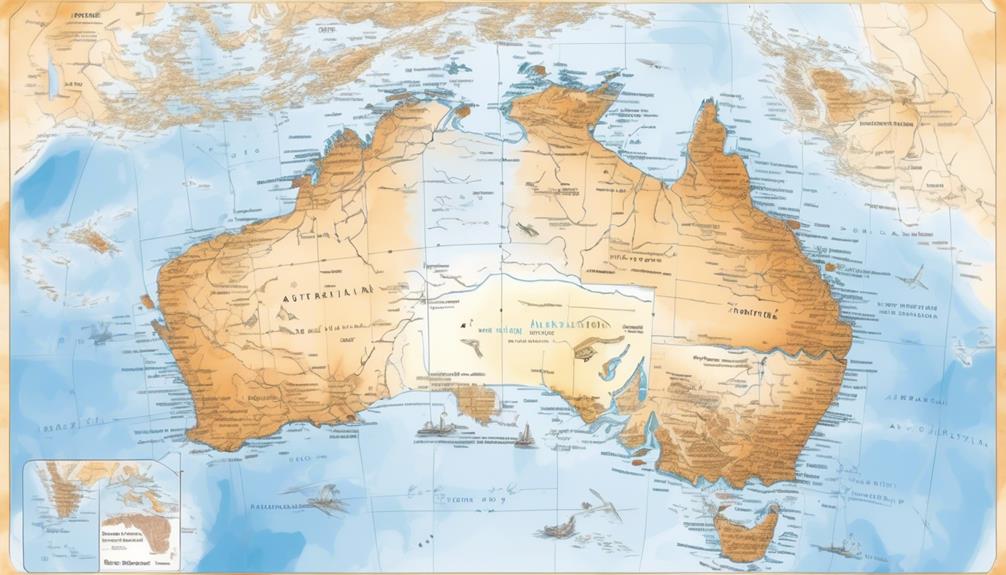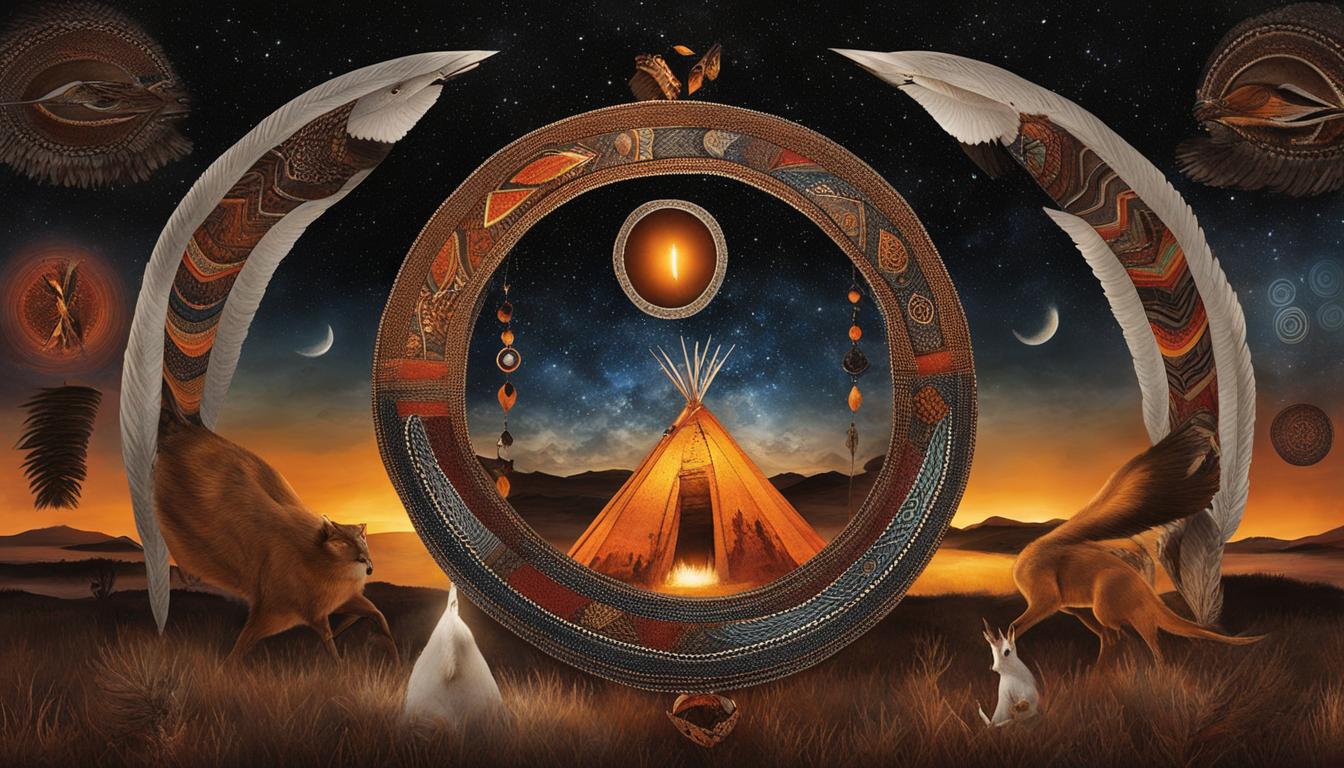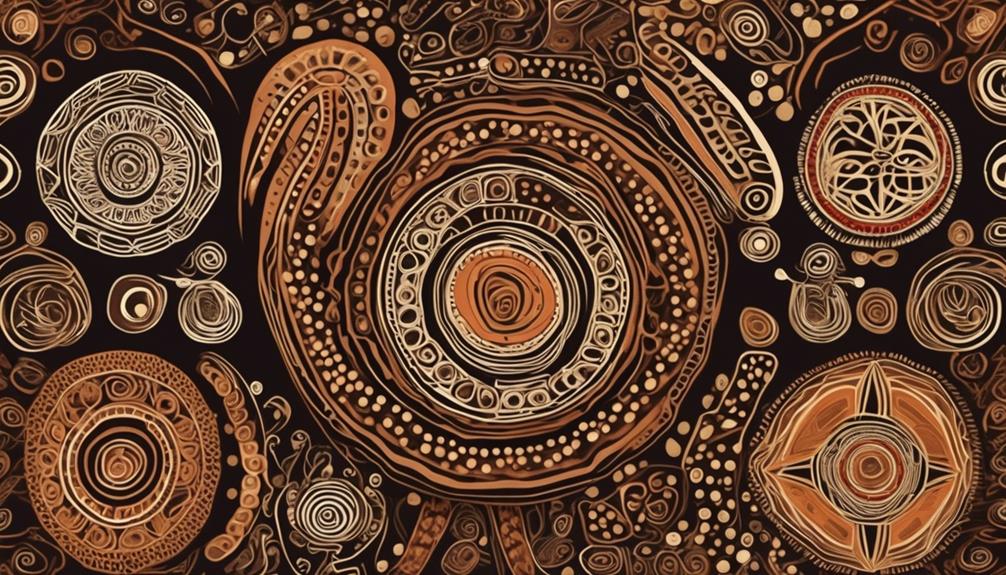When I first learned about the discovery of Mungo Man, the ancient remains found in New South Wales, I became intrigued by the origins of the Australian Aboriginal population.
As we explore this topic, it becomes increasingly clear that the origins of the Aboriginal people are deeply intertwined with the complexities of human migration and the ancient history of our world.
The journey of uncovering their origins is not only a fascinating exploration of ancient history but also sheds light on the rich and enduring heritage of the Indigenous people of Australia.
Key Takeaways
- Arrival in Australia around 65,000 years ago
- Deep genetic connection to ancestral lands for over 50,000 years
- Use of ancient land bridges and coastal seafaring routes for migration
- Aboriginal communities' adaptation to the environment and sustainable land management practices
Early Human Arrival in Australia
Upon arrival in Australia, early humans encountered a diverse and challenging environment that shaped their adaptation and survival strategies. Human migration to Australia is a topic of great interest to archaeologists and anthropologists. The archaeological evidence suggests that the first humans arrived in Australia around 65,000 years ago, making it one of the earliest known human migrations. This migration is a remarkable feat considering the geographical barriers and distances involved.
The archaeological evidence supporting the early human arrival in Australia is compelling. Stone tools, rock art, and other artifacts found at sites such as Madjedbebe in the Northern Territory provide crucial insights into the lifestyles of the earliest inhabitants. These findings reveal a sophisticated understanding of the environment and resource management, indicating successful adaptation to the challenges of the Australian landscape. The discovery of ancient hearths and food remains further demonstrates the early humans' ability to thrive in diverse environments, including arid and tropical regions.
The migration of early humans to Australia also raises questions about the routes they may have taken and the reasons behind their journey. The presence of ancient tools in Australia suggests that these early migrants possessed seafaring technology, allowing them to navigate across waterways. This challenges previous notions of early human capabilities and highlights the complexity of their migration.
Genetic Studies and Ancestral Origins
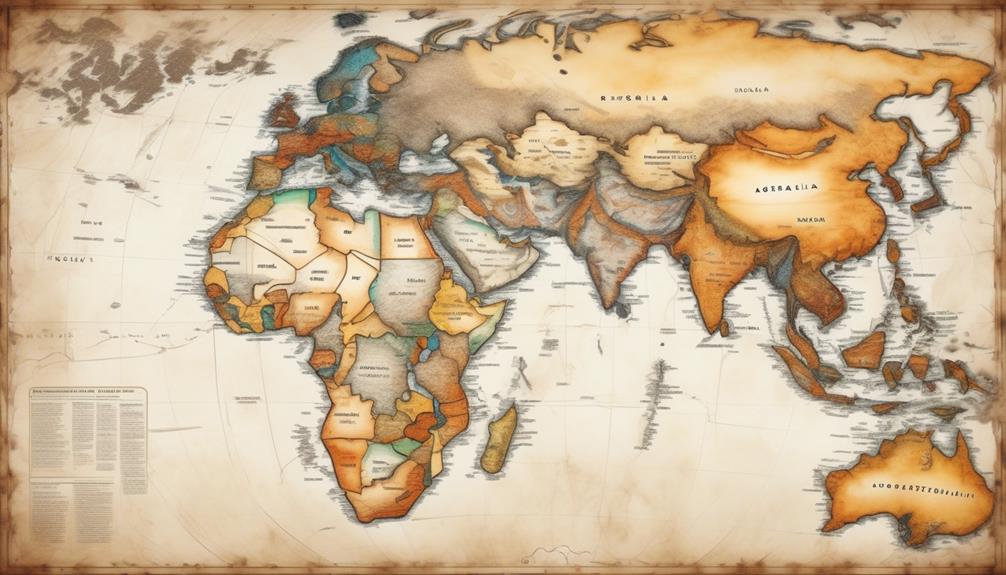
We will analyze ancestral DNA to gain insights into the genetic origins of Australian Aboriginal populations and their connections to other groups.
By exploring migration patterns and genetic markers, we aim to shed light on the ancient movements and interactions that have shaped the diversity and ancestry of Indigenous Australians.
This genetic research will provide valuable information about the deep ancestral origins of Aboriginal peoples, contributing to a more comprehensive understanding of their history and heritage.
Ancestral DNA Analysis
DNA analysis and population genetics offer valuable tools for exploring the ancestry of Australian Aboriginal peoples. By analyzing the genetic markers present in modern Aboriginal populations and comparing them to those of other groups around the world, researchers can infer patterns of migration, intermixing, and divergence. These studies have revealed complex and ancient lineages, shedding light on the deep roots of Aboriginal peoples in Australia.
Additionally, ancestral DNA analysis enables the identification of specific genetic adaptations to the Australian environment, providing clues about the ways in which Aboriginal populations have evolved in response to their unique surroundings. Overall, genetic studies play a crucial role in unraveling the rich and intricate history of Australian Aboriginal origins.
Migration Patterns Exploration
Using genetic studies and ancestral DNA analysis, we can explore the migration patterns of Australian Aboriginal populations to gain insights into their ancestral origins.
- Human Dispersal
- Genetic studies have revealed that the ancestors of Australian Aboriginal people were part of the first wave of human migration out of Africa, around 75,000 years ago.
- The genomic analysis indicates that they migrated through Asia and arrived in Australia around 50,000 years ago.
- Indigenous Settlement
- Examination of mitochondrial DNA has shown that Aboriginal populations have maintained a deep genetic connection to their ancestral lands for over 50,000 years.
- Analysis of Y chromosome diversity has provided evidence of extensive genetic diversity among Aboriginal male lineages, indicating long-term settlement and adaptation to diverse environments across Australia.
Prehistoric Migration Routes
We will now examine the prehistoric migration routes that may have been taken by the ancestors of Australian Aboriginal peoples.
Our analysis will focus on the potential use of ancient land bridges and coastal seafaring routes that may have facilitated the movement of early populations.
These migration routes are crucial in understanding the dispersal of human populations across the Australian continent and the broader implications for the origins of Aboriginal peoples.
Ancient Land Bridge
During prehistoric times, ancient land bridges provided essential migration routes for early human populations, including Australian Aboriginal ancestors. The land bridge theory suggests that these ancient pathways, such as the now-submerged Sahul and Sunda land bridges, facilitated the migration of humans into Australia. This theory is supported by genetic evidence, archaeological findings, and geological studies, contributing to our understanding of prehistoric migration theories.
The Sahul land bridge, which once connected Australia, Tasmania, and New Guinea, is of particular interest due to its role in shaping the genetic and cultural diversity of the Australian Aboriginal peoples. Additionally, the Sunda land bridge, which connected mainland Southeast Asia to present-day Indonesia, likely played a crucial role in the dispersal of human populations throughout the region.
These land bridges are integral to comprehending the intricate patterns of ancient human migration.
Coastal Seafaring Routes
Coastal seafaring routes served as crucial pathways for prehistoric human migration, enabling the dispersal of populations across vast stretches of the Earth's coastlines. Coastal navigation and maritime exploration were fundamental to the movement of ancient peoples, including the ancestors of Australian Aboriginals. These routes facilitated the exchange of goods, ideas, and genes, shaping the cultural and genetic landscapes of diverse populations. The table below illustrates some of the significant coastal seafaring routes that likely played a pivotal role in prehistoric migration.
| Seafaring Route | Region |
|---|---|
| Pacific Coast | Southeast Asia |
| Indian Ocean | South Asia |
| Mediterranean Coast | North Africa and Europe |
Understanding the seafaring routes of our prehistoric ancestors provides valuable insights into the complex patterns of human migration and the interconnectedness of ancient civilizations.
Ancient Aboriginal Settlement Patterns
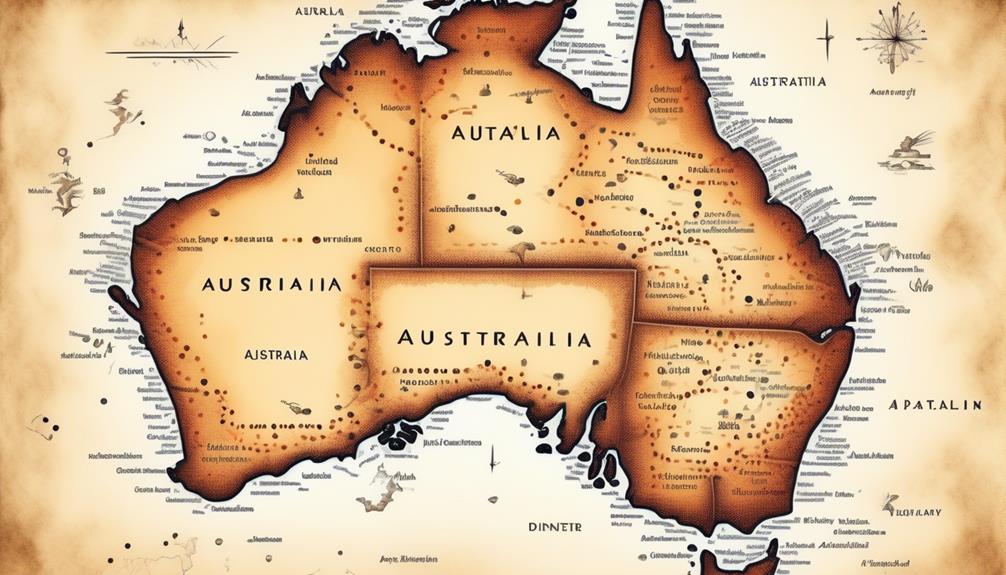
Recent archaeological findings indicate a diverse range of ancient settlement patterns among Australian Aboriginal communities. These settlement patterns have been uncovered through extensive research and analysis of archaeological evidence, shedding light on the ways in which Aboriginal populations established and organized their communities across the vast and varied landscape of Australia.
- Settlement Patterns:
- *Nomadic Lifestyle*: Archaeological evidence suggests that some Aboriginal communities followed a nomadic lifestyle, moving from one location to another in search of food, water, and other essential resources. This pattern of settlement reflects the deep understanding and adaptation to the natural environment that characterized Aboriginal societies.
- *Sedentary Settlements*: In contrast, other Aboriginal groups established more permanent settlements, where they developed sophisticated systems for resource management and social organization. These sedentary settlements often exhibited evidence of complex social structures and cultural practices, providing valuable insights into the rich diversity of Aboriginal societies.
The examination of ancient Aboriginal settlement patterns offers a nuanced understanding of the adaptive strategies and cultural developments that shaped the lives of Australia's first inhabitants. By meticulously analyzing archaeological evidence, researchers continue to unravel the complexities of Aboriginal settlement patterns, contributing to a deeper appreciation of the enduring legacy of Australia's Indigenous peoples.
Environmental Adaptation and Cultural Evolution
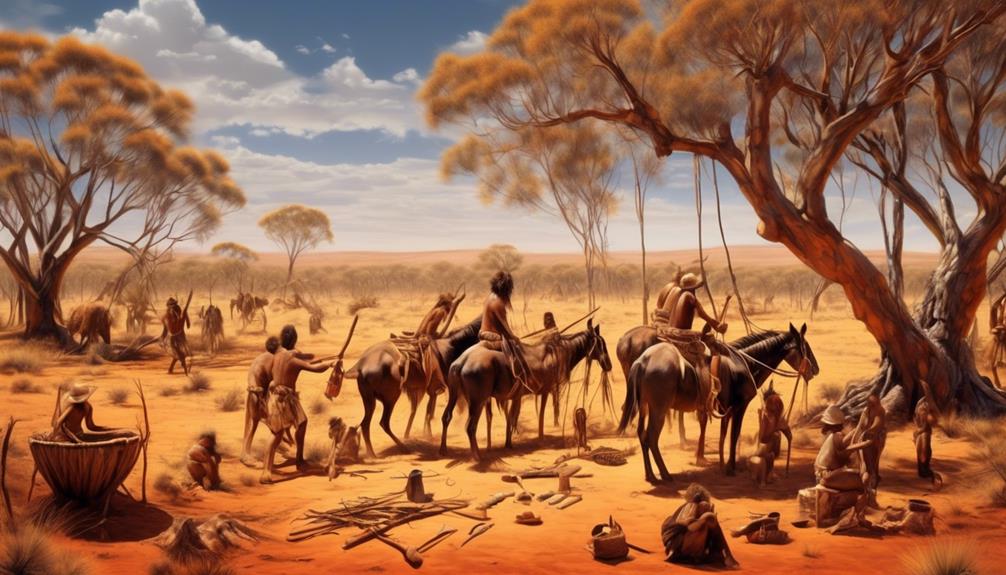
Examining the ways in which Australian Aboriginal communities adapted to their environment and evolved culturally provides valuable insights into the early history of Indigenous peoples in Australia. Cultural adaptation among Australian Aboriginals was crucial for their environmental resilience. The Aboriginal people developed a deep understanding of the land, enabling them to thrive in diverse and often harsh environments.
This cultural adaptation was evident in their sophisticated knowledge of local flora and fauna, their sustainable land management practices, and their ability to adapt to climatic changes.
Cultural evolution among the Aboriginal communities was also shaped by their environmental adaptation. The rich diversity of languages, kinship systems, and artistic expressions among different Aboriginal groups reflects their long history of cultural evolution in response to varying environments. For instance, the development of complex social structures and trade networks enabled efficient resource allocation and distribution, contributing to their resilience in challenging environments.
Furthermore, the spiritual beliefs and rituals of the Aboriginal peoples were closely tied to their environment, reflecting a deep understanding of the natural world and the interconnectedness of all living things. This cultural adaptation fostered a strong sense of stewardship and conservation, ensuring the sustainable use of resources.
Aboriginal Connection to Land and Country
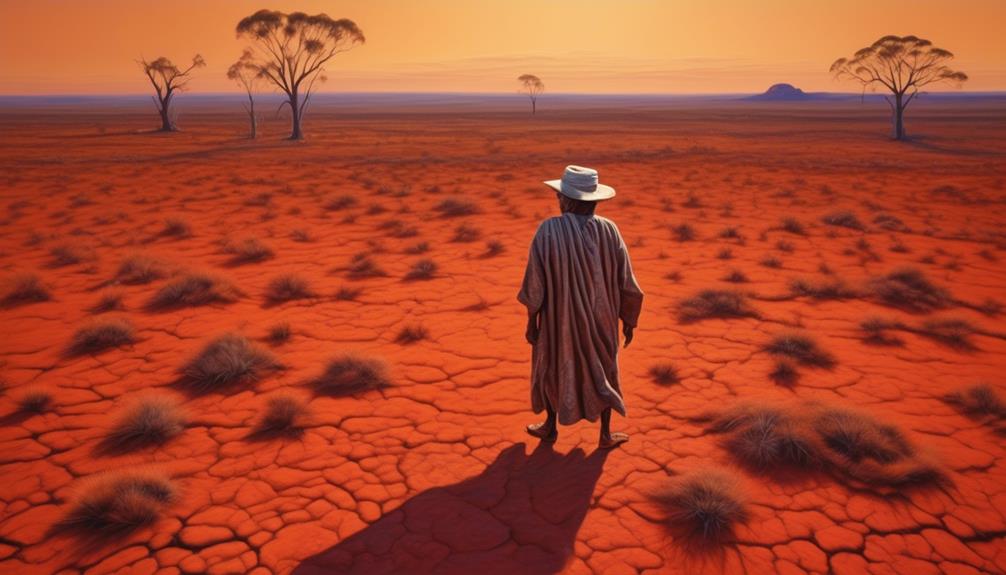
The cultural adaptation and environmental resilience of Australian Aboriginal communities have laid the foundation for their profound and enduring connection to the land and country. This connection to the land is deeply rooted in the cultural heritage of Aboriginal peoples and is intricately linked to their spiritual beliefs, social structures, and traditional practices.
- Connection to Land:
- *Spiritual Significance:* The land isn't merely seen as a physical entity but holds spiritual significance, with Dreamtime stories and creation beliefs deeply embedded in the landscape.
- *Sustainable Practices:* Aboriginal communities have developed sustainable land management practices over millennia, utilizing controlled burning techniques and rotational hunting and gathering to maintain the ecological balance.
- Cultural Heritage:
- *Ancestral Ties:* The land holds the ancestral remains and artifacts of Aboriginal peoples, reinforcing their spiritual and emotional connection to specific sites and landscapes.
- *Art and Storytelling:* Aboriginal art and oral traditions serve as a means of connecting with the land, preserving cultural knowledge, and passing down stories of the land from generation to generation.
The enduring connection to the land and country has, however, been significantly impacted by colonial forces, leading to dispossession, displacement, and the disruption of traditional practices. The imposition of Western land tenure systems, urbanization, and environmental degradation have posed significant challenges to maintaining this connection. Despite these challenges, the Aboriginal connection to the land remains a fundamental aspect of their cultural identity and continues to be a source of resilience and strength in the face of ongoing societal changes.
Impact of Colonial Encounters
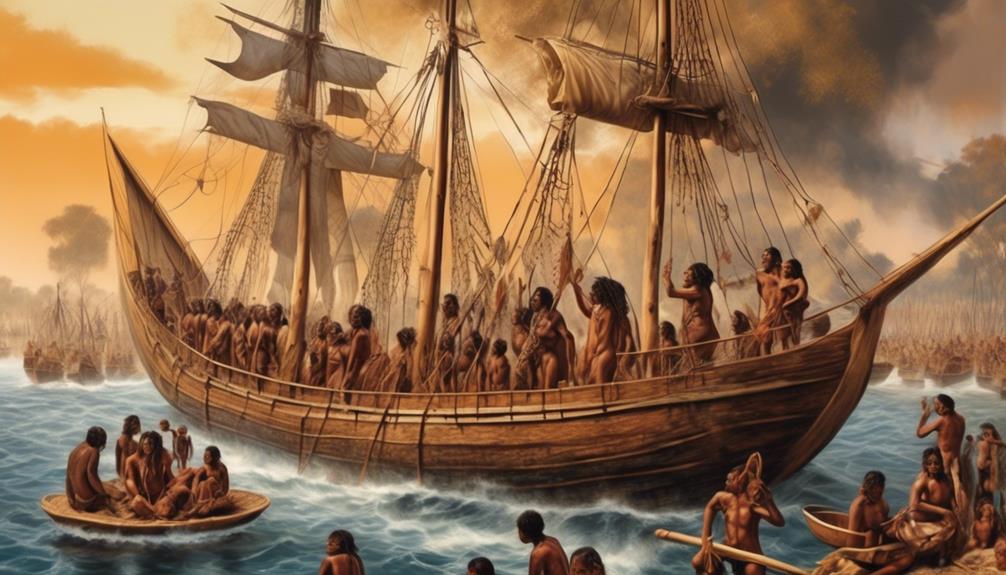
Having endured the impact of colonial encounters, Australian Aboriginal communities have faced significant disruptions to their traditional way of life and cultural practices. The impact of cultural assimilation has been particularly profound, as European colonizers sought to impose their own cultural norms and values on the Indigenous population. This has led to the erosion of traditional languages, spiritual beliefs, and social structures within Aboriginal communities.
The imposition of European systems of governance and land ownership has also had a detrimental effect on Aboriginal societies. The concept of private land ownership introduced by the colonizers conflicted with the traditional Aboriginal connection to land and country, leading to the displacement of many Indigenous peoples from their ancestral territories. This displacement has contributed to a sense of dislocation and loss within Aboriginal communities, as they've been separated from the land that holds deep spiritual and cultural significance.
In the face of these challenges, indigenous resistance movements have emerged as a powerful force for preserving traditional practices and asserting Aboriginal rights. These movements have sought to reclaim and protect sacred sites, revitalize traditional languages, and promote cultural practices that have been threatened by colonial influences. By resisting cultural assimilation and asserting their rights to land and cultural heritage, Aboriginal communities have demonstrated resilience and determination in the face of ongoing challenges.
Contemporary Aboriginal Identity and Heritage
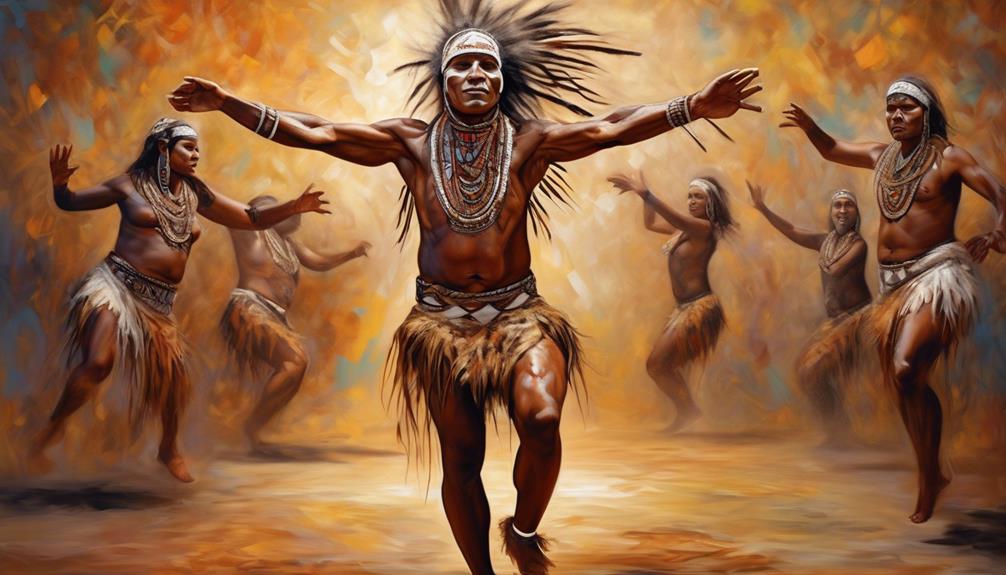
Our examination of contemporary Aboriginal identity and heritage reveals a dynamic and multifaceted interplay between tradition and adaptation within Indigenous communities. The complexities of contemporary Aboriginal identity are shaped by a variety of factors, including historical legacies, cultural revitalization efforts, and ongoing social, political, and economic challenges.
At the heart of contemporary Aboriginal identity lies a profound connection to ancestral heritage, which continues to serve as a source of strength, resilience, and cultural renewal for Indigenous communities across Australia.
- Cultural Revitalization Efforts
- Indigenous communities have been actively engaged in efforts to reclaim and revitalize traditional languages, customs, and practices, fostering a renewed sense of cultural pride and continuity.
- These revitalization efforts are crucial in shaping contemporary Aboriginal identity, as they provide a platform for the transmission of ancestral heritage to younger generations, ensuring its preservation for the future.
- Challenges and Adaptation
- Contemporary Aboriginal identity is also influenced by the ways in which Indigenous communities navigate the complexities of modernity, including urbanization, globalization, and the ongoing impact of colonial legacies.
- Despite these challenges, Indigenous peoples continue to adapt and innovate, drawing on their ancestral heritage as a source of resilience and empowerment in the face of contemporary social and political dynamics.
Frequently Asked Questions
How Did the Australian Aboriginal People Develop Their Unique Cultural Practices and Traditions?
We believe the Australian Aboriginal people developed their unique cultural practices and traditions through centuries of cultural adaptation and social organization.
Their deep connection with the land and environment influenced their belief systems, art, storytelling, and social structures.
This intricate web of practices and traditions reflects their resilience and ability to thrive in diverse environments, shaping a rich and diverse cultural heritage that continues to be celebrated and preserved today.
What Evidence Exists to Support the Theory of Ancient Aboriginal Migration Routes?
Migration routes of ancient Aboriginal people are supported by genetic evidence.
Our research indicates that DNA analysis has revealed a complex history of migration and settlement across Australia. By examining genetic markers, we've identified patterns that align with traditional migration routes and provide compelling evidence for the ancient movements of Aboriginal populations.
This genetic evidence not only supports the theory of migration routes but also sheds light on the rich history and diversity of Aboriginal cultures.
How Have Environmental Changes Impacted Aboriginal Communities Over Time?
Environmental changes have significantly impacted Aboriginal communities over time. Their deep understanding of the land and natural resources has allowed for environmental adaptation and community resilience.
By adapting hunting and gathering practices, they've sustained their traditional lifestyles. However, factors like climate change and colonization have posed challenges.
The ability to navigate these changes reflects the resilience of Aboriginal communities in the face of environmental shifts.
What Are Some of the Lesser-Known Aspects of Contemporary Aboriginal Identity and Heritage?
Contemporary Aboriginal identity is a rich tapestry woven with traditional knowledge and cultural resilience. This intricate interplay shapes a vibrant heritage that often goes unnoticed.
The lesser-known aspects of contemporary Aboriginal identity encompass diverse cultural practices and artistic expressions, providing a window into a dynamic and evolving heritage.
Understanding these facets is crucial for appreciating the depth and complexity of Aboriginal identity in the modern world.
What Role Did Women Play in Ancient Aboriginal Settlement Patterns and Cultural Evolution?
In ancient Aboriginal settlement patterns and cultural evolution, women played a crucial role. They were often responsible for gathering food, caring for children, and maintaining social networks within and between communities.
Their influence on settlement decisions and resource management shaped the development of Aboriginal societies.
Conclusion
In conclusion, the origins of Australian Aboriginal people are as complex and diverse as the country itself. Like the roots of a sprawling tree, their ancestral origins can be traced back through genetic studies and prehistoric migration routes.
Their deep connection to the land and country is like the unbreakable bond between a river and its banks. Despite the impact of colonial encounters, their cultural resilience and identity continue to thrive, shaping the rich tapestry of contemporary Australia.
